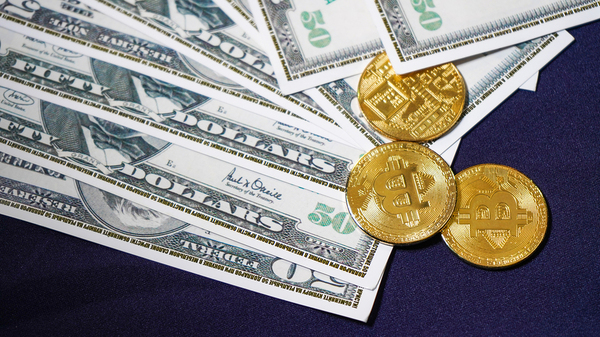
With central bank digital currencies (CBDCs) having become a major talking point in financial circles across the globe, it seems like it will only be a matter of time until we could witness the launch of a new global digital currency that – unlike bitcoin – would launch with intergovernmental approval.
In this article, you will learn how a global, blockchain-powered “Digital Dollar” could potentially emerge as the world’s new reserve currency.

How the Dollar Got So Powerful
“We’ve been working quietly, away in the cool woods and mountains of New Hampshire. And I doubt if the world – it understands how big a thing we are bringing to birth.” – John Maynard Keynes, July 1944
Toward the end of World War II, a collection of nations got together to figure out what the financial world would look like after the war. The global economy had been a mess after World War I, and governments were eager for a do-over.
Holed up in a luxury hotel in New Hampshire, the greatest economists and financial thinkers debated ideas for a new financial world order. The “Bretton Woods Conference,” like most conferences, was more like a party, with exotic dancers and enormous amounts of alcohol. But while they partied hard, they also worked hard.
The central problem was how to stimulate trade between nations after the war: how to create a “central money.” Previously, gold had been used as an international currency, but many nations were off the gold standard, allowing them to print money. How could everything be pegged to a single unit of value?
The debate eventually came down to two competing ideas. On one side was the brilliant British economist John Maynard Keynes, who suggested an international currency called Bancor. A country could still use its own money, but when you traded with other nations, you’d use Bancor. There would be a central Bancor bank, located in London.
On the other side of the debate was Harry Dexter White, a guy you’ve probably never heard of, but who ultimately played one of the most important roles in U.S. history. White also argued for a global currency: the U.S. dollar.

Where our modern financial system was born: Mount Washington Hotel in Bretton Woods, NH.
The story of how White ultimately triumphed over Keynes is brilliantly captured in this National Public Radio piece. It is a masterpiece of political maneuvering and social engineering. Whenever White was debating this new global money – which he did frequently – he referred to it as a “gold-convertible currency,” without referring to what that currency might be.
Since the U.S. owned most of the world’s gold supply, he then sneakily suggested that everyone just use “U.S. dollar” as a placeholder until they figured it out. That got everyone used to thinking about the U.S. dollar as the international currency (just as today’s world leaders use their Twitter accounts to test out equally audacious ideas).
One day, while Keynes was off creating the World Bank, someone angrily demanded that White explain exactly what this “gold-convertible currency” might be. Without Keynes there to stop him, the British representative, probably exhausted and hungover, suggested they officially use “U.S. dollar” as a placeholder in the formal proposal, thinking this was a minor point of procedure.
That was all the permission that White needed. He had his staff stay up all night, replacing every instance of “gold-convertible currency” with “U.S. dollar” in the official 96-page written proposal. And once it was in print, it was in process. Thus did the U.S. dollar become the world’s currency.
Ultimately, White’s tricky tactics won out: today, when you want to trade, everyone recognizes the U.S. dollar. That is an extremely powerful position—arguably the most powerful position in the world.
Why would the United States give that up? Because bitcoin.
Digital Money is a Dollar Disruptor
The dollar may be the “train” pulling the global economy, but the “payment rails” (i.e., the financial infrastructure that the train runs upon) are slow and outdated.
In an age when we can send an email instantly and free, it is still time-consuming and expensive to wire dollars to other countries. (Just try sending an international bank transfer.) This slows down the global economy and limits growth. It keeps many people – about 20% of the world – outside the banking system altogether.

Blockchain-based digital currencies such as bitcoin provide a solution: digital money that has the potential to be virtually instant and free. We don’t know if bitcoin will ultimately win out, but it seems likely that one digital currency will ultimately disrupt the dollar.
So why not bring the dollar into the age of blockchain?
Imagine a coalition of countries – a bit like the Libra Association – who get together to plan a one-world global currency. This is decentralized digital money that can be sent and spent anywhere in the world, quickly and cheaply. It will simplify payments and speed up trade.
Like Libra, no one country “owns it”: it’s more like an open-source project that anyone can use. But the country that oversees its development will have the strongest position: observe how IBM has taken an active role in development of Hyperledger, cementing its leadership position in enterprise blockchain.
Let’s call it the Digital Dollar.
It’s a dollar in name only: in order to truly work, the Digital Dollar needs to be decentralized, running on a distributed collection of nodes, free from the influence of a central bank. It needs to be like bitcoin, but better. It needs to be faster, cheaper, and more stable. It needs to work just like cash.
International, Not National
At the close of the Bretton Woods Conference, U.S. Treasury Secretary Henry Morgenthau stated that it was the end of economic nationalism. The leaders of the new world, he said, must build a financial system that lowers barriers to trade and the movement of money.
Well, his heart was in the right place.
Since the 1970s, economists have been increasingly critical of the decision to make the U.S. dollar the currency of global trade. Keynes’ idea – a global money outside any single nation – would have undoubtedly made for a much different world.
Now, 75 years later, we have the opportunity for another do-over. We can still keep the dollar (in name only). But let’s move it onto the blockchain. Let’s decentralize the dollar.
Sign up here to get more blockchain intelligence and insight in our free weekly newsletter.